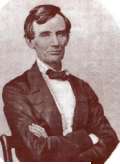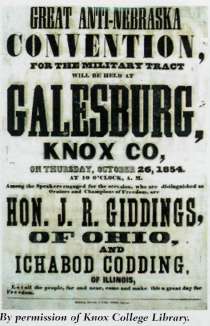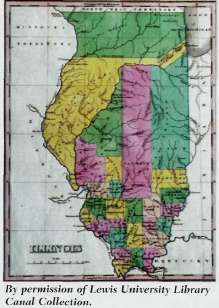 |
Home | Search | Browse | About IPO | Staff | Links |
 |
Home | Search | Browse | About IPO | Staff | Links |
Surfing for Lincoln "The Abraham Lincoln Historical Digitization Project" by Drew VanDeCreek The Abraham Lincoln Historical Digitization Project brings primary source materials shedding light on Abraham Lincoln's Illinois years to the public on its Lincoln/Net World Wide Web site (http://lincoln.lib.niu.edu). These materials, drawn from the Chicago Historical Society, the University of Chicago Library, the Newberry Library, Northern Illinois University Libraries, and other Illinois institutions, include Lincoln's letters, speeches, and other works from his Illinois years (1830-1861). But they also include a wide variety of other primary source materials illuminating his context. The Project began in 1998 as a partnership in which a number of Illinois institutions, including museums, archives, and research and academic libraries, sought to share their historical materials with the public. With the advent of the Internet and World Wide Web, representatives of these institutions met in the forum provided by a statewide library consortium to discuss potential ways they might use the new technologies to produce a digital library site combining materials from each of their collections. The subject of Abraham Lincoln quickly came to the fore. While the Library of Congress and National Archives hold large collections of Lincoln's presidential materials, resources from his life before the presidency remain scattered throughout the collections of individual libraries, museums, archives, and private individuals. Among these many collectors, Illinois institutions boasted some of the largest and most coherent collections of pre-presidential Lincoln resources and Lincolniana. United in a single World Wide Web site, these materials could prove extremely useful to a variety of audiences. For more than a decade online digital libraries have provided World Wide Web users with free access to a wide variety of historical materials. While research scholars and students enrolled in a formal course of instruction may make good use of large digital libraries such as Lincoln/Net, members of the general public may wonder "What should I search for?" Readers of Illinois Heritage may thrive on research in primary sources, but to many individuals, exploring 30 million words of text dating from a period over 150 years ago may seem quite challenging. In order to make these materials more accessible to a general audience, the Lincoln/Net World Wide Web also features interpretive materials discussing the context in which these materials were created. In addition to a brief, original Lincoln biography placing local and national events in a temporal context, the site features original interpretive essays using episodes from Lincoln's life to present a public audience with an overview of the literature in each of these eight fields: Economic Development and Labor; Native American Relations; Law and Society; Political Development; African-Americans and White Americans' Racial Attitudes; Religion and Culture; and Women's Experience and Gender Roles. These materials can help individuals visiting the Lincoln/Net site to identify their own interests amidst these events and interpretations, and formulate questions with which they may search the databases. Lincoln the icon 
Abraham Lincoln clearly represents a popular, even iconic, figure in American history. But Lincoln's iconic stature did not begin with his assassination, or even his election to the presidency. During the heated campaign of 1860, Republican Party managers identified Lincoln, as yet largely unknown outside of his native Northwest, as a "rail splitter," a "representative man" who shared experiences with many average Americans. Like many of his countrymen, Lincoln had moved west with his family in search of a better life. He had worked with his hands on farms and steered keelboats down the Mississippi. He could boast of very little formal education, and had failed in a number of occupations before finding that his talents suited the practice of law. As a politician he had lost more elections than he had won, but now had gained another opportunity to seize the main chance. When Republican leaders chose to identify Abraham Lincoln as a representative man, they hoped that he would serve as a lens through which Americans, or at least non-slaveholding Americans, might see themselves. Likewise, Abraham Lincoln serves Illinois Heritage 23 as a lens through which today's World Wide Web users may examine and interpret the past, and thus provides the Lincoln/Net site with an interpretive framework. His life experiences shed light upon significant themes that historians have developed in their discussion of the antebellum period. Lincoln's early struggles illuminate the realm of economic development and labor in this period, and his role in the 1832 Black Hawk Indian War temporarily placed him at the center of the unfolding tragedy in which American settlers removed Native Americans from their lands. Lincoln's subsequent legal career brings issues of law and society to the forefront, and his well-known political activities outline the rise and fall of the Second Party System, including the genesis and development of Whig and Democratic political cultures in this period. Much of Lincoln's political activities came to focus upon the "irrepressible conflict" stemming from black slavery and, hence, race relations. Like many other Americans, Lincoln confronted the period's evangelical religion and made his peace with it. Like many other American men, our sixteenth president married, raised a family, and wrestled with the nineteenth century's rapidly changing gender roles. Streaming Lincoln In addition to materials that Lincoln himself wrote, Lincoln/Net's databases include over 30 million words of searchable primary source materials drawn from participating institutions' rich Illinois history collections. These materials include Illinoisans' letters, diaries, and journals, as well as a large number of published travelogues and other descriptive works. The project's databases also include over 2,500 images and 100 sound files. These sound resources provide World Wide Web users with present-day recordings made from nineteenth century song-books. Together, Lincoln/Net's online databases provide the public with a large collection of historical materials from antebellum Illinois. While searchable databases provide digital library users with powerful tools for the exploration of text, image, and sound materials, the Abraham Lincoln Historical Digitization Project has been among the leaders in introducing newer technologies as well. Dynamic historical maps generated by Geographic Information Systems (GIS) technology provide the Lincoln/Net site with an innovative way to present primary source materials to the public. GIS maps provide project users with an opportunity to explore another type of historical resource: statistical data gathered by censuses or latter-day social scientists. At the same time that librarians and humanities scholars developed online digital libraries filled with searchable databases of texts, images, sound files, and video files, geographers and their collaborators in the world of systems analysts and computer programmers developed Geographic Information Systems. GIS provides an opportunity for its users to examine and analyze spatially oriented materials in dynamic new ways. It manages and displays map information 24 Illinois Heritage 
in a database environment that enables its users to submit queries, which in turn instruct the GIS software to create maps depicting only the types, or "layers," of information that the user has requested. For example, a GIS user may request a map of a region representing its railroad network, on a specific date, alone, without the clutter created by other types of information. That user might also ask GIS technology to render a map depicting the railroad network as well as results from the United States Census for a particular year, rendered to represent population density, for example. This map might facilitate preliminary research on the relationship between railroad development and economic development. The ability to isolate, depict, and overlay these layers of information makes GIS a formidable tool for the integration and analysis of a wide variety of data, and provides individual GIS users with a flexibility that facilitates inquiry and research. In the years immediately following its introduction in the early 1990s, GIS users employed stand-alone computer workstations to tap data-bases and generate dynamic map resources. This state of affairs largely restricted usage of the technology's dynamic data layering and map generation capacities to professional geographers, university professors and their students, and employees of well-funded business concerns and government agencies. But by the late 1990s GIS developers and vendors had adapted their technology for ready use on the World Wide Web in the form of products such as Environmental Systems Research Institute (ESRI)'s ArcIMS. This development places Geographic Information Systems' considerable analytical power within the reach of a much larger audience, including, potentially, the users of online digital libraries. Much like digital libraries utilize metadata and full-text string searching to make text, image, sound, and video materials both accessible and subject to manipulation and analysis for a dramatically expanded audience, Geographic Information Systems unlock the potential of spatially-oriented data. In the case of the Lincoln/Net site, these maps depicting electoral returns and demographic data enable users to place Lincoln and his contemporaries in another layer of context. 
New technologies also allow the Lincoln/Net site to provide its users with interpretive materials in multiple formats. In addition to its interpretive essays, Lincoln/Net also features over one hundred streaming video files in which leading historians discuss episodes in Lincoln's life as they relate to major themes in their scholarly publications. Lincoln Project staff members hope that these resources will enable Web users to fashion their own forms of a popular public history format. Ken Burns' popular historical films largely consist of close-up, lovingly-shot views of primary source materials such as images and manuscripts, interspersed with interpretive commentary by expert scholars. The Lincoln/Net site provides its users with an opportunity to echo Burns' general approach in their own use of the World Wide Web. Lincoln/Net visitors browsing text, image, and sound materials may at any time refer to the site's main menu to seek video resources in which scholars, speaking in conversational language, place these materials in an interpretive context. The Abraham Lincoln Historical Digitization Project's Lincoln/Net World Wide Web site uses a variety of new technologies to help its users to explore Lincoln's life and times in antebellum Illinois. In recent years a new generation of online digital libraries have provided research scholars and enrolled students with a dazzling array of readily accessible primary source materials. But members of the general public, lacking professional training or classroom instruction in the particulars of Lincoln's era, often struggle to use such resources. A mass of primary sources may seem impenetrable, or even intimidating. Online interpretive materials provide these individuals with an opportunity to benefit from historians' discussions of these materials. These resources, discussing the context in which historical actors created these materials can provide World Wide Web users with an opportunity to identify sets of materials of particular interest to them, and help them to construct hypotheses and questions. In the end, Lincoln/Net's collection of online interpretive materials can provide members of the general public with the tools they need to take up historical research for themselves. Drew E. VandeCreek is Director of Digital Projects at Northern Illinois University Libraries. Illinois Heritage 25 |Home|
|Search|
|Back to Periodicals Available|
|Table of Contents|
|Back to Illinois Heritage 2006|
|